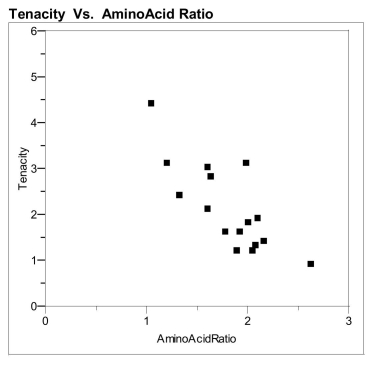a) What is the equation of the least-squares
line for predicting tenacity using amino
b) Graph the least squares best fit line on the scatter plot
that appears on the next page.
acid ratio Amino acid ratio and tenacity for linings for 16 Japanese kimonos
c) Approximately what proportion of the variability in
tenacity is explained by the linear relationship
between tenacity and the amino acid ratio? The theory of fiber strength suggests that the relationship between fiber tenacity and amino acid ratio is logarithmic, i.e. , where is the tenacity and is the amino acid ratio. Perform the appropriate transformation of variable(s) and fit this logarithmic model to the data.  protein and biodegradable. It would be beneficial
protein and biodegradable. It would be beneficial
to be able to assess the delicacy of a fabric before
making decisions about displaying it in a
museum. Chemical analysis might give some
evidence about the brittle nature of a fabric. Bio-
chemical data were acquired from the linings of
Some delicate fabrics are natural silks, made of  sixteen 19th and early 20th century Japanese
sixteen 19th and early 20th century Japanese
kimonos. Investigators measured the
concentration of certain amino acids ("Amino
acid ratio") as well as the breaking stress
("tenacity") of the 16 kimono fabrics.
Correct Answer:
Verified
View Answer
Unlock this answer now
Get Access to more Verified Answers free of charge
Q2: Assessing the "goodness" of a regression line
Q10: The slope of the least squares line
Q16: One of the properties of Pearson's r
Q22: The study of prehistoric birds depends
Q23: life without their physical capture and
Q23: The theory of fiber strength suggests that
Q27: The Des Moines Register reported the
Q28: Does the transformed model appear to be
Q28: As early as 3 years of
Q29: Assessing the "goodness" of a regression line
Unlock this Answer For Free Now!
View this answer and more for free by performing one of the following actions

Scan the QR code to install the App and get 2 free unlocks

Unlock quizzes for free by uploading documents